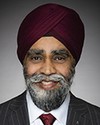Thank you.
Are CAF personnel still deployed via Operation Laser, and if yes, where are they deployed?
Evidence of meeting #3 for National Defence in the 43rd Parliament, 2nd session. (The original version is on Parliament’s site, as are the minutes.) The winning word was make.
A recording is available from Parliament.
Conservative

Cheryl Gallant Conservative Renfrew—Nipissing—Pembroke, ON
Thank you.
Are CAF personnel still deployed via Operation Laser, and if yes, where are they deployed?
Liberal

Harjit S. Sajjan Liberal Vancouver South, BC
Currently, we don't have any folks inside any long-term care facilities, but we are poised to be able to provide that appropriate support. There has been a request for supporting some indigenous communities, but not directly for Operation Laser.
Has anything changed on that, Vice?
LGen Mike Rouleau
Minister, I would only add the small numbers of people who are helping some of our other government department friends in relation to go-forward planning and logistics work.
Conservative

Cheryl Gallant Conservative Renfrew—Nipissing—Pembroke, ON
Was there a staging area outside the facilities, a place where the armed forces personnel could don their PPE before going in and then doff it after coming out, so that it was kept separate from the regular clothes they wore?
LGen Mike Rouleau
Yes, Minister.
Madam Chair, thank you for the question.
Yes, JTF Central and FOI (Est) had their own tactics, techniques and procedures they were using. There absolutely were areas that as you got progressively closer to them, the quote, unquote, “affected zones”, people would stage out of the dress of the day, out of their current uniform, and transition progressively into the medical piece.
In fact, that's one of the biggest things that we brought to the chaotic situation. It was this sense of tactics, techniques and normalizing a very frenetic environment.
Liberal

Yves Robillard Liberal Marc-Aurèle-Fortin, QC
Minister, thank you for joining us this morning.
I would first like to thank the Canadian Armed Forces, on behalf of Quebec, for the work they have done in long-term care facilities. I have a number of questions about that.
How exactly did their training and preparation on entering long-term care facilities go?
Liberal

Harjit S. Sajjan Liberal Vancouver South, BC
I'm going to let the vice take this question, but I want to add to it first and say just how impressed I was with how the Canadian Armed Forces took something that they have never done before and prepared themselves with the appropriate training and the right level of training, because it was about saving lives but also about treating the elderly with the dignity and respect that they deserved. That's exactly what they did, and the systems that they put into place, the training that they put into place and the support that they got from the Red Cross for that training were absolutely immense.
Vice, do you want to give the details of that?
LGen Mike Rouleau
Thank you, Mr. Chair.
The only thing I would add is that this was certainly a non-traditional deployment. The medical staff of the Canadian Armed Forces worked closely with each facility's coordinators to create formal courses. So all deployed troops had to participate in training of two or three days, I think. In other words, not a single military member was sent without having taken that training.
Liberal

Yves Robillard Liberal Marc-Aurèle-Fortin, QC
Thank you.
After the departure of most of the Canadian Armed Forces members, some specialized units remained on site.
Can you tell us a bit about their work?
LGen Mike Rouleau
Thank you for your question on specialized staff, but I am not sure I understand it.
When the mission was completed, in late June, Canadian Armed Forces troops that were sent to long-term care facilities were brought back. Of course, the Montreal headquarters has remained in contact with provincial authorities. At the time, I was commanding the operation, and I don't remember that actual specialized forces were left in the facilities.
Liberal

Yves Robillard Liberal Marc-Aurèle-Fortin, QC
Can you also tell us about the transition to Red Cross?
LGen Mike Rouleau
Thank you for your question.
I don't have much to give you on that because, obviously, that was not a task that came under the Canadian Armed Forces. We worked in collaboration with provincial authorities. I have made recommendations to the chief of the defence staff concerning how long we should stay, given all the other tasks that we have to fulfill.
Finally, federal and provincial authorities had the task to work with Red Cross to train a team within it. It is not up to the Canadian Armed Forces to train those people.
Liberal

Harjit S. Sajjan Liberal Vancouver South, BC
Mr. Robillard, if I could just add to that, on the transition that took place, in the measures that the Canadian Armed Forces put into place to make sure that the long-term care facility was able to carry out its task, we were able to set up a structure and give confidence that it could be handed over....
When the Red Cross had to come in and hand back full responsibilities to the facilities, it's those measures that the Canadian Armed Forces put in—which were probably a little more stringent than by the provinces themselves—that gave confidence to the long-term care facilities that things could carry on. When the Red Cross came in, this allowed them to provide that support and they were able to transition much more smoothly.
Liberal

Yves Robillard Liberal Marc-Aurèle-Fortin, QC
Overall, the Canadian Armed Forces services have been very appreciated across Canada, but especially in Quebec, since we are talking about Quebec.
Bloc

Alexis Brunelle-Duceppe Bloc Lac-Saint-Jean, QC
Thank you, Madam Chair.
In December 2017, the Government of Canada solicited competitive bids to permanently replace 76 Royal Canadian Airforce CF-18 Hornet fighter jets.
Minister, how much money has been put into the interim fighter capability project and the future fighter capability project to date?
Liberal

Harjit S. Sajjan Liberal Vancouver South, BC
The replacement of the F-18 has been extremely important to our government. As you know, this project has been going on for a long time—even before our government—and we committed to a competition to replace the current F-18s.
One of the problems we had was that we also had mission supply: We had our NORAD commitments and we had our NATO commitments. That's why it was important for us to be able to invest in our current F-18 fleet. We also bought additional aircraft of the same type from Australia, some of which are ready.
The total project is costing approximately $339 million for the upgrade. The upgrades we're doing are to the defensive suite and also to combat capability of the fighters. This will allow us to continue to be able to fly our missions and meet our commitments while we replace our future fighter capability.
There are currently three companies in the mix. Obviously, I can't talk more about that because they're in a very sensitive stage of that competition.
Bloc

Alexis Brunelle-Duceppe Bloc Lac-Saint-Jean, QC
How do you explain the decision to purchase 88 new fighter jets instead of a different number of aircraft?
Liberal

Harjit S. Sajjan Liberal Vancouver South, BC
The number we based it on is.... When I became the Minister of National Defence, it was initially to buy 65. I asked the same question, why is the number 65?
We had to take a look at our current responsibilities, our NORAD commitments plus our NATO commitments, were. Based on those two main commitments, plus the training we had to do, that is how we came up with the number of 88 aircraft.